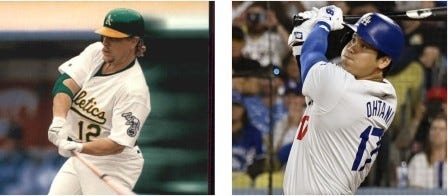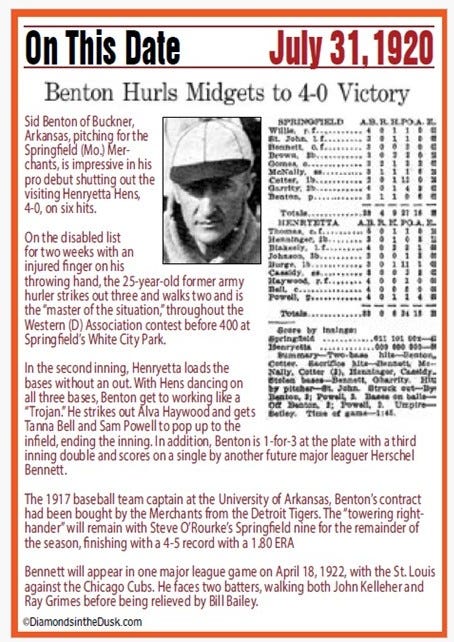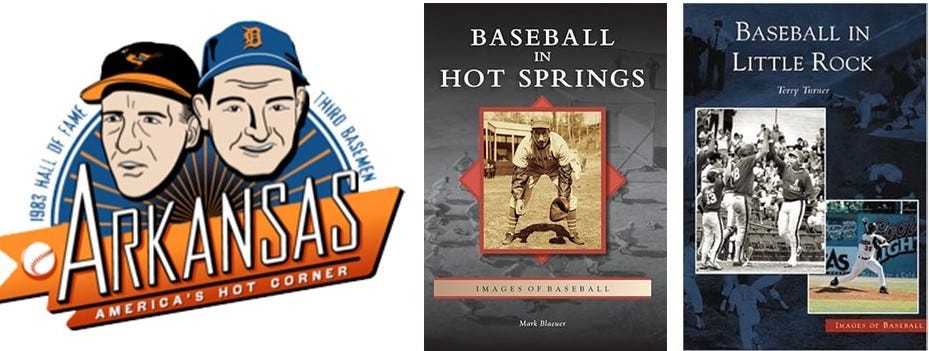A Subscription sends these weekly posts to your mailbox. There is no charge for the subscription or the Backroads and Ballplayers Weekly.
If you do not wish to subscribe, you will find the weekly posts on Monday evenings at Backroads and Ballplayers on Facebook. SAVE THE LINK
Ohtani Ties Dee Fondy, Diamonds in the Dusk, Sid Benton’s Lost Story, A Celebration in Hot Springs
In case you missed…Ohtani Reaches 1,000
I am not sure how you could not have seen, read, or heard about Shohei Ohtani’s 1,000th hit on Wednesday afternoon. It was the lead story on every baseball source I saw that evening. I had to read a few paragraphs down to see that the Dodgers lost the game to those juggernauts from Missouri, the St. Louis Cardinals.
Appropriately, Ohtani’s 1,000th hit was also his 264th home run. Both are significant accomplishments for a 31-year-old star. Significant, yes. Hall of Fame benchmarks, not even close. Rogers Hornsby had 2,299 hits by age 32. Aaron had 2,266, and Vada Pinson had 2,118. If I compared Ohtani to Vada Pinson, I would get some laughs or frowns.
If my research is correct, this week’s 1,000th major league hit tied Dee Fondy and Birdie Tebbits for 1342nd place on the all-time hits list. His 264th home run moved him past Danny Tartabull and into a temporary tie for 228th with Bobby Thompson. Bearing an unforeseen catastrophe, Shohei should catch Matt Stairs soon.
I take some good-natured grief from some of my buds who accuse me of not “liking” Shohei Ohtani. I actually like him, and I think he is a heck of a power hitter. He is the best designated hitter of his time and one of the best DHs ever. It is the guys who talk about him as if he is Babe Ruth or Ichiro Suzuki that are hard to take. To me, he is neither yet. He is getting close to Big Papi in perception, although he isn’t halfway to Ortiz’s career totals in home runs and hits.
“Stay with us, folks. Coming up, the (fill in the blank team name) versus the Dodgers. You will see the best baseball player ever to wear a uniform.” Pretty much word for word at the end of a pregame show.
_________________________________
A Lost Story: “Sid Benton’s Cup of Coffee”
I am often asked where I find the lost stories of Arkansas baseball history. One of my favorite resources is a blog by a North Carolina blogger named Brian Morrison. Morrison posts some of the 20th century’s most obscure stories, and often his tales are about Arkansas guys.
Country boys who suddenly find themselves in cities with a little money and lots of free time can supply some amazing stories. Most are true! A few are tragic, and some are funny.
Brian’s work is published in a blog/column called Diamonds in the Dusk. Last week, he featured a guy I had written about in my book.
Sid Benton of Buckner, Arkansas, had a two-batter big-league career. Check out Brian’s story. I have added Benton’s bio from my book, Backroads and Ballplayers.
If you like the lost tales from baseball’s colorful early years, you will want to be a regular reader of Diamonds in the Dusk.
_________________________
Lost Story - Sid Benton Gets a Big-League Cup of Coffee
On April 3, the Arkansas Razorbacks opened the 1917 baseball season. Sid Benton, a 23-year-old Fayetteville native, was the team captain and the starting pitcher on that opening day against the University of Missouri. Benton and the Razorbacks lost 8 – 1. In describing Benton’s less-than-stellar performance, the Arkansas Gazette compared his erratic lack of control to the March Hare.
One week later, in a move related to the war effort and unrelated to the unpromising beginning of the season, the Gazette announced that University of Arkansas President J. C. Futrall had cancelled the remaining baseball season. Five Aprils later, the newspaper would be far more complimentary.
On Tuesday, April 4, 1922, the St. Louis Cardinals were working their way home to start the major league season. The Cards had held spring training in Orange, Texas, and were playing exhibition games against minor league teams on the way to St. Louis. On this day, the Cardinals played in Little Rock against the Southern Association’s Little Rock Travelers.
In preparation for the opening of the season in ten days, the Cardinals wanted to take another look at Sid Benton, a former college pitching star and one of their top prospects. Coincidentally, Benton would get his big-league audition in his home state.
Three future Hall of Famers were on the field that day, including St. Louis’ legendary manager, Branch Rickey, and seven-time batting champion, Rogers Hornsby. Rickey would become a historic figure as a baseball executive later in his career and be selected for the Hall in 1967. Hornsby would become the standard by which major league hitters were judged in the first half of the 20th century. The Travs had 18-year-old Travis Jackson at short. By season’s end, the Waldo, Arkansas, native would be in the majors, beginning his Hall of Fame career.
The Cardinals were the major league team of choice in Arkansas, and they had baseball’s best hitter, Rogers Hornsby. Most of the crowd, which braved threatening weather at Little Rock’s Kavanaugh Field that day, was there to see Hornsby and the major league Cardinals.
Future major league pitcher, Leo Dickerman, who would later retire to Atkins, Arkansas, started the game on the mound for the home Travelers. The 27-year-old former University of Arkansas right-hander, Sid Benton, would get the start for the major leaguers. Benton had been impressive in spring training, and, although tabbed as a minor league pitcher, the Cards had added him to their roster a few days earlier to take one more look.
The game was disappointing for those who came to watch Hornsby. He would lead the National League in 1922 in runs, hits, doubles, RBIs, and batting average, but on this day, Hornsby went 0 – 3 against Dickerman, hit into a double play, and struck out. The star of the game was the unheralded rookie from South Arkansas, Sid Benton. When a spring storm forced the game to be called after five innings, Benton had allowed the Travs only a single hit. Although determined to report about Hornsby’s lack of success, the Arkansas Gazette wrote glowingly about the rookie pitcher who was “threatening to become a St. Louis Cardinal pitching star.”
Sidney Wright Benton was born in 1894 in Buckner, Arkansas, a sawmill town in northern Lafayette County. Early in Benton’s life, the family moved to Fayetteville, where his father was a traveling salesman for a seed company. Sid Benton grew up on Block Street in Fayetteville, Arkansas, a short walk from the field where the University of Arkansas Cardinals played their intercollegiate baseball games. By age 17, he had enrolled at U of A, and in the spring of 1912, he earned a spot as a pitcher on the recently rechristened Arkansas Razorbacks. Benton became one of the mainstays of U of A baseball for the next five seasons. After college, he remained in the area and became a farmer and businessman.
Benton was farming at Prairie Grove just west of Fayetteville and playing semi-pro games for local teams when he was signed in 1920 by the Springfield Merchants of the Western Association. Benton was already 25 years old and getting a late start in pro baseball. He was 5 – 4 with Springfield and had a sparkling 1.80 ERA in an 11-game trial.
In the spring of 1921, Springfield newspapers reported Benton had been promoted and was working out with Omaha in the Class A Western League. In August, he landed in Sioux Falls, a Class D minor league team in the Dakota League, but was released when he failed to get in condition to pitch. BaseballReference.com shows no statistical record for Benton with either team in 1921.
Despite a nomadic 1921 that saw him start with high hopes of a promotion to Class A Omaha and end with his release by Class D Sioux Falls, the Cardinals signed the ex-Razorback captain in the spring of 1922. In late February, Benton found himself in Orange, Texas, for spring training with the Cardinals. He had a good spring, but as the Redbirds headed north, Benton prepared for a minor league season. Nothing in his history indicated otherwise for a pitcher who had failed to make the Sioux Falls Soos the previous August.
The Redbirds broke camp in Texas in late March and meandered toward St. Louis by way of New Orleans. They met their cross-town rivals, the St. Louis Browns, in the Big Easy for a four-game series, and Branch Rickey was not satisfied with the pitching. He decided to give one more shot to an unproven rookie who had looked so good in spring training.
On April 3, the Cardinal’s train stopped in Shreveport, where Rickey picked up Sid Benton for one last look. The next day, his dominating, rain-shortened outing in Little Rock would earn Benton a spot on the St. Louis Cardinals’ opening day roster.
The Cardinals opened the season by winning four of their first five games. On April 18, the Redbirds entertained the Chicago Cubs for the second game of a four-game series. Veteran Jeff Pfeffer, whose best years were behind him, would get his first start on that Tuesday afternoon. Pfeffer would later surprise Cardinal Manager Branch Rickey by becoming the ace of the staff with 19 wins in 1922. His first start did not indicate this future success. Pfeffer gave up three runs in the first inning and walked the first man he faced in the second. Rickey had seen enough and summoned reliever Lou North to finish the second inning.
Rickey sent up a pinch hitter for North when he came up in the bottom of the second. In the Cubs’ half of the third, the Cardinals called on the rookie pitcher from Arkansas for his first and last major league appearance.
John Kelleher, the Cubs’ third-place hitter, led off against Benton. Kelleher had hit .309 in 1921 as a rookie for the Cubs. Benton had not worked since April 4th in Little Rock, and he promptly walked Kelleher. Next up for the Cubs was future Little Rock Traveler, Ray Grimes. Benton proceeded to walk Grimes. Starting the inning with two walks and putting runners on first and second, and no outs was enough for Branch Rickey. The manager called on Arkansan Bill Bailey to relieve Benton.
Sid Benton’s major league career was over. He had faced two hitters and failed to record an out. When the Cards headed out for a road series in Pittsburgh the next day, Benton boarded a train bound for Texas.
Benton wound up with Galveston in the Texas League, where he struggled to regain his form from spring training. In June, he was diagnosed with meningitis and sent home. Benton recovered by July, but his 3 – 4 record and 4.17 ERA were not going to earn another look by the Cardinals. In December, Rickey sold Benton to Fort Smith of the Western Association. Disgruntled and fortified by a college education that allowed him more choices than other pro baseball players in 1923, Sid Benton went home.
Sidney Wright Benton worked in insurance and investments in his hometown of Fayetteville, Arkansas, until his death in 1977. Benton’s brief major league career consisted of one appearance, facing two batters, and walking both.
___________________________
Hot Springs Baseball Weekend, August 8 and 9
Come by and say hello at our Robinson-Kell SABR table:
Discount books by Arkansas authors, door prizes, and information about our upcoming meeting on August 23 with guest Chris Curry
________________________









See you tomorrow!